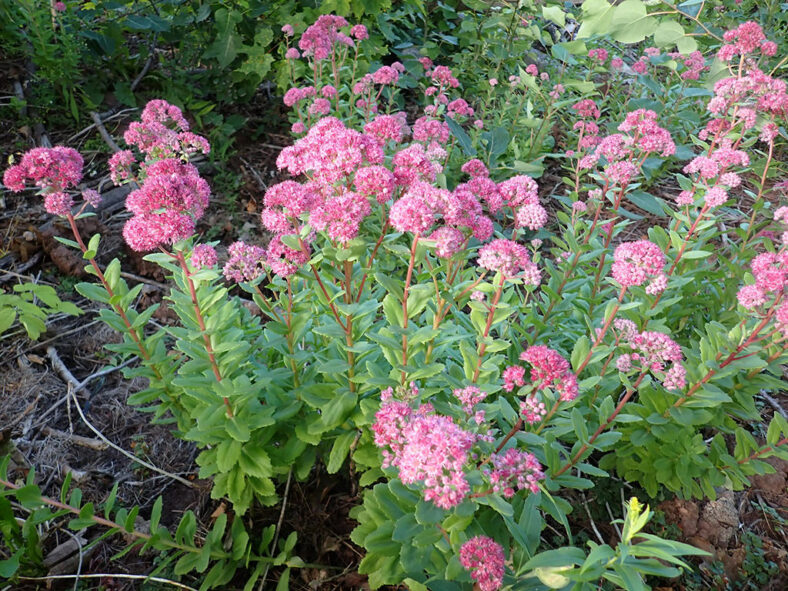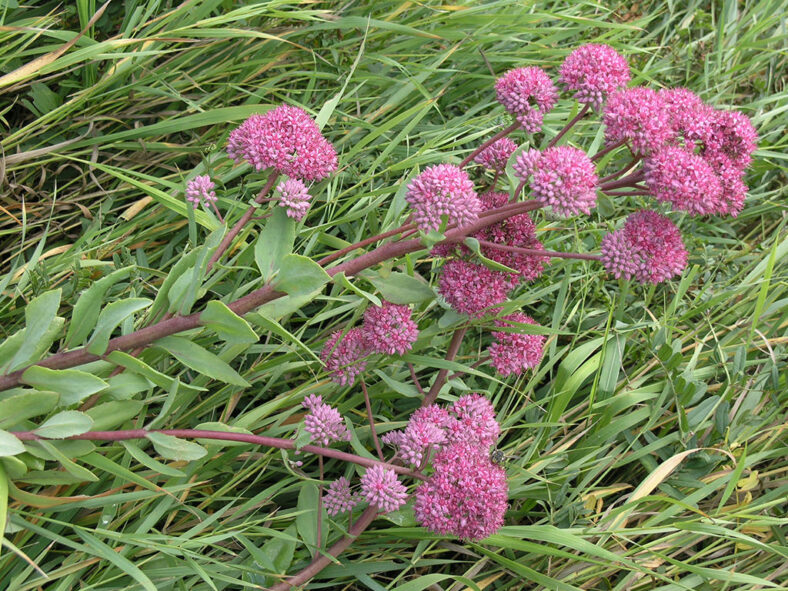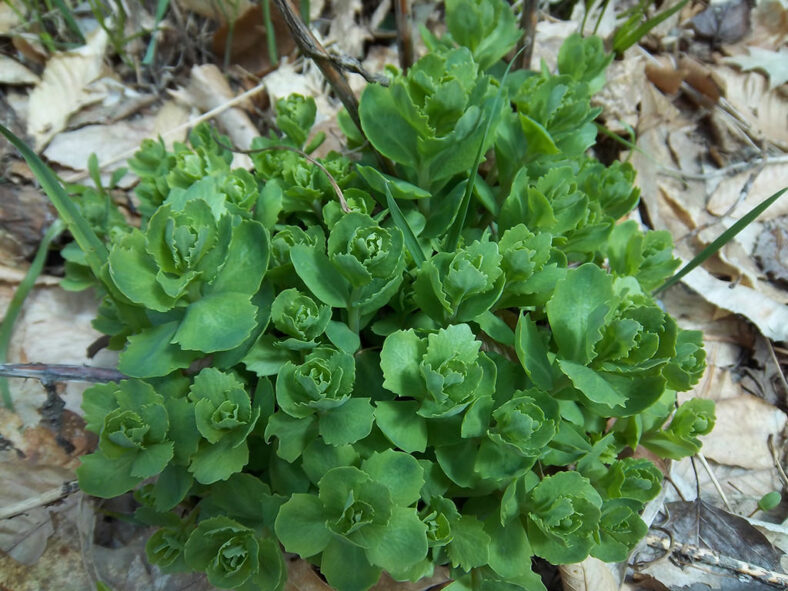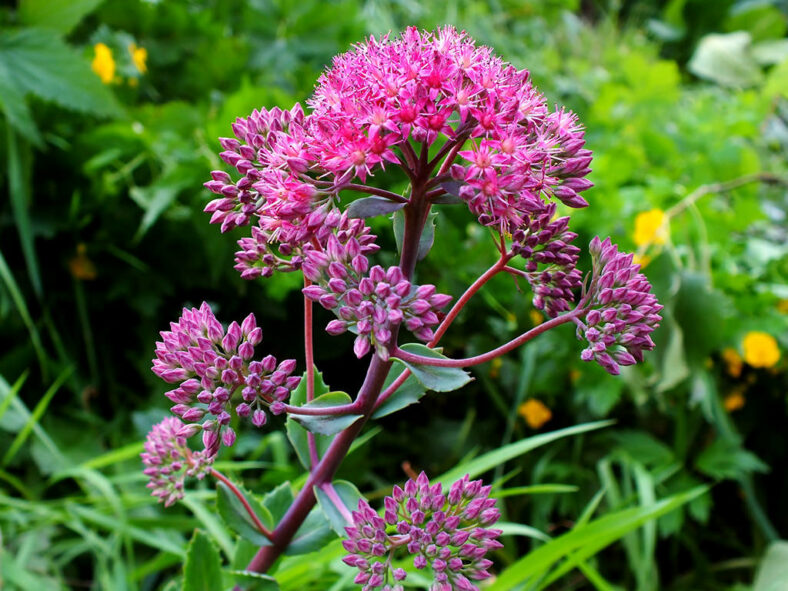Scientific Name
Hylotelephium telephium (L.) H. Ohba
Common Name(s)
Frog's Stomach, Garden Orpine, Garden Stonecrop, Harping Johnny, Life-everlasting, Live-forever, Live-forever Stonecrop, Livelong, Midsummer Men, Orphan John, Orpine, Purple Stonecrop, Witch's Moneybags
Synonym(s)
Hylotelephium telephium subsp. telephium, Sedum telephium
Scientific Classification
Family: Crassulaceae
Subfamily: Sempervivoideae
Tribe: Telephieae
Genus: Hylotelephium
Etymology
The specific epithet "telephium (te-LE-fee-um)" honors Telephus, King of Mysia and son of Heracles, who suffered from a spear wound that would not heal until treated by rust scraped from the spear that had caused the wound.
Origin
Hylotelephium telephium is native to central and eastern Europe and eastern Asia but has been widely introduced elsewhere, particularly in North America. It grows in fields, around hedges, hills, and gravelly or calcareous soils.
Description
Hylotelephium telephium, formerly known as Sedum telephium, is a succulent plant with erect, ascending, or rarely pendulous stems that bear dull green leaves. The flowering stems can grow up to 24 inches (60 cm) tall from a short rootstock with numerous fusiform roots, forming upright to semi-upright mounds. The leaves are oblong, elliptic to narrowly ovate, with usually strongly toothed margins, and can grow up to 2.4 inches (6 cm) long and 1 inch (2.5 cm) wide. They are often glaucous and sometimes tinged red.
The star-shaped, reddish-purple flowers appear in dense, many-flowered clusters, usually terminal or sometimes from the axils of upper leaves, from late summer to fall. The foliage dies back to the ground in the winter, and new stems arise in the spring.

Hardiness
USDA hardiness zone 5a to 9b: from −20 °F (−28.9 °C) to 30 °F (−1.1 °C).
How to Grow and Care for Hylotelephium telephium
Light: This succulent prefers full sun. It tolerates light to partial shade in hot summer climates but will produce weak, floppy growth when grown in too much shade. Plant your H. telephium in an area of your garden that gets 6 hours of sunlight daily.
Soil: H. telephium does not need rich soil but requires excellent drainage. You can choose a commercial potting mix for succulents or make one yourself.
Temperature: This plant is cold-hardy and tolerant of heat and drought, making it a popular outdoor succulent. H. telephium can withstand temperatures as low as -30 °F (-34.4 °C). USDA Plant Hardiness Zones 4a to 9b, -30 to 30 °F (-34.4 to -1.1 °C).
Watering: The best way to water H. telephium is to use the "soak and dry" method. Get the soil completely wet, and then wait until it is dry before watering again.
Fertilizing: Feed annually with a balanced fertilizer. As new growth appears in spring, apply fertilizer to the soil according to the package directions.
Repotting: Plants grown in containers require more care than those grown in gardens. When your H. telephium outgrows its current pot, move it to a larger pot that will better hold the plant. Spring is the best time for repotting. Make sure the soil is dry before you begin.
Propagation: This succulent can be grown from seeds, division, or stem cuttings. Sow the seeds in spring. Dividing your H. telephium is easy and can be carried out at almost any time in the growing season, though it is probably best done in spring or early summer. Propagate by stem cuttings in summer.
Learn more at How to Grow and Care for Hylotelephium.
Toxicity of Hylotelephium telephium
H. telephium can be mildly toxic to humans and animals.
Subspecies, Cultivars, and Hybrids of Hylotelephium telephium
- Hylotelephium telephium subsp. ruprechtii
- Hylotelephium 'Carl'
- Hylotelephium 'Purple Emperor'
- Hylotelephium 'Xenox'
Links
- Back to genus Hylotelephium
- Succupedia: Browse succulents by Scientific Name, Common Name, Genus, Family, USDA Hardiness Zone, Origin, or cacti by Genus
Photo Gallery
Click on a photo to see a larger version.


